Canadian military bands

The Music Branch of the Canadian Armed Forces is composed of 6 full-time regular force bands, 53 part-time reserve force bands and 15 voluntary bands.[1] Bands of the Music Branch are often badged with the unit or base insignia that they support.
The concert band in the Canadian Armed Forces are referred to officially as "Brass and Reed" bands. They are performing ensembles consisting of several members of the woodwind instrument family, brass instrument family, and percussion instrument family. The Band Branch also has pipe and drum bands. There is also a dedicated String quartet attached to the Central Band of the Canadian Armed Forces. Most bands also form smaller ensembles to suit a wide variety of performance venues, including show bands, jazz ensembles, rock bands, Celtic ensembles, brass quintets, woodwind quintets, parade bands, and Dixie bands.
The Regular Force musicians are selected nationally by competitive audition prior to enlisting.[2] Members of these bands often come from prestigious conservatories and schools of music. Reserve force musicians are hired and trained at the discretion of the local unit to which they apply. The training and career progressions of both components are separate. Until the early 21st century the Music Branch also had drum and bugle corps and corps of drums within all branches of the Canadian Armed Forces.
Performances
Military brass and reed bands perform as a marching band in parades, military parades, or seated, in concert, and play a part in military funeral, convocation, ceremonies such as Trooping the Colour, and parades. They participate in community events such as Remembrance Day parades and band concerts. These bands wear a mix of standard military service dress (either battle dress, DEU or shirtsleeves) and Highland dress as appropriate.
Repertoire
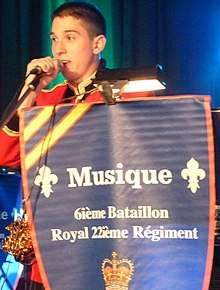
The military bands play ceremonial and marching music, including the national anthems and patriotic songs. A concert band's repertoire includes original wind compositions, arrangements of orchestral compositions, light music, popular tunes and concert marches found in standard repertoire.
Professional bands
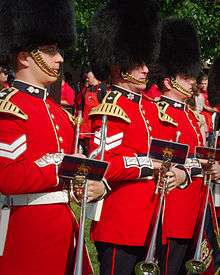
The Royal Canadian Navy has two Regular Force professional brass-reed bands in Canada. They are: The Stadacona Band in Halifax Regional Municipality commanded by Maritime Forces Atlantic. The Naden Band in Esquimalt, British Columbia commanded by Maritime Forces Pacific.
In addition to the two Regular Force Navy bands listed above, The Royal Canadian Navy has five additional brass-reed bands based out of the following Naval Reserve units: HMCS Chippawa in Winnipeg, Manitoba; HMCS Montcalm in Quebec, Quebec; HMCS Star in Hamilton, Ontario; HMCS Tecumseh in Calgary, Alberta, and HMCS York in Toronto, Ontario. Historically, HMCS Carleton in Ottawa, Ontario; HMCS Discovery in Vancouver, British Columbia; HMCS Donnacona in Montreal, Quebec; had Naval Reserve bands; however, they were cut in the early 1990s.
Each summer, musicians from the five active Naval Reserve bands come together to form the National Band of the Naval Reserve and perform throughout Canada. They have played at every single Halifax International Tattoo since the mid 1970s, performed on Parliament Hill, at the National War Memorial, at Grey Cup parades, for royal visits and countless other events.
The Canadian Army has a number of Regular Force professional brass-reed bands commanded by 5th Canadian Division: The Royal Canadian Regiment Band in Gagetown, New Brunswick; 1st Battalion, Royal Newfoundland Regiment in St. John's, Newfoundland and Labrador; 3rd Field Artillery Regiment, RCA, in Saint John, New Brunswick;8th Canadian Hussars (Princess Louise's) in Moncton, New Brunswick; Halifax Military District in Halifax Regional Municipality; The Prince Edward Island Regiment (RCAC) in Charlottetown, Prince Edward Island. The Canadian Army has a number of Regular Force professional pipe bands commanded by 5th Canadian Division: 1st Battalion, The Nova Scotia Highlanders (North) in Amherst, Nova Scotia; and The Cape Breton Highlanders in Sydney, Nova Scotia. The Canadian Army has a number of voluntary brass-reed bands commanded by 5th Canadian Division: CFB Chatham and CFB Greenwood. The Canadian Army has a number of voluntary pipe bands commanded by 5th Canadian Division: CFB Greenwood; CFB Gagetown and 2 Canadian Mechanized Brigade Group The Royal Canadian Regiment in Gagetown, New Brunswick. The Canadian Army has a number of Regular Force professional brass-reed bands commanded by 2nd Canadian Division
Voluntary Bands
The Canadian Forces has a number of voluntary bands. Voluntary bands are staffed with one or two regular force members who serve as musical instructors and administrators.
The Royal Military College of Canada Bands in Kingston, Ontario, consist of a voluntary brass-reed and a voluntary pipe band, commanded by National Defence Headquarters.
The Royal Canadian Air Force has four authorized volunteer bands, located at 4 Wing Cold Lake Alberta, 8 Wing Trenton Ontario, 14 Wing Greenwood Nova Scotia, and 22 Wing North Bay Ontario. With the exception of 22 Wing they consist of a volunteer brass-reed concert band and a voluntary pipe and drum band. 22 Wing does not have a pipe and drum band. By custom, military and civilian volunteer musicians parading as part of a band may be authorized to wear the uniforms of that band as optional items. No rank insignia shall be worn unless the individual holds that rank by right. Appointment badges such as that of drum major may be worn.

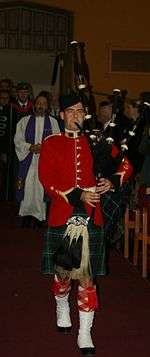 Royal Military College of Canada Bag piper and Padre dyring Convocation ceremony in Currie Hall, Royal Military College of Canada, fall 2011
Royal Military College of Canada Bag piper and Padre dyring Convocation ceremony in Currie Hall, Royal Military College of Canada, fall 2011 Royal Military College of Canada Drum Line perform under Black Lights
Royal Military College of Canada Drum Line perform under Black Lights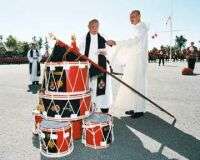 Consecration of Royal Military College of Canada Colours
Consecration of Royal Military College of Canada Colours Royal Military College of Canada Military band centennial album 1975
Royal Military College of Canada Military band centennial album 1975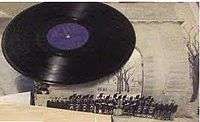
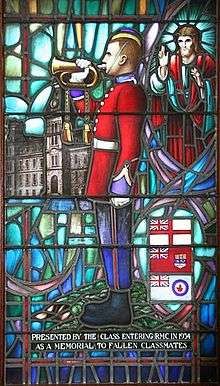 Memorial Stained Glass window, Class of 1934, Royal Military College of Canada
Memorial Stained Glass window, Class of 1934, Royal Military College of Canada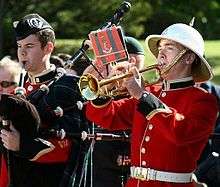 Royal Military College of Canada band piper and bugler, Remembrance Day
Royal Military College of Canada band piper and bugler, Remembrance Day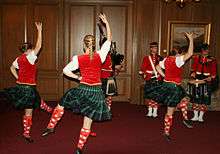 Royal Military College of Canada Scottish highland dancers, piper, and drummers perform
Royal Military College of Canada Scottish highland dancers, piper, and drummers perform
List of Canadian Forces military bands
- The Stadacona Band of Maritime Forces Atlantic (MARLANT)(Halifax, N.S.),
- The Naden Band of Maritime Forces Pacific (MARPAC) (Esquimalt, B.C.),
- HMCS Montcalm (Quebec City, QC),
- HMCS York (Toronto, ON),
- HMCS Star (Hamilton, ON),
- HMCS Chippewa (Winnipeg, MB),
- HMCS Tecumseh (Calgary, AB),
- The Central Band of the Canadian Armed Forces (Ottawa, Ontario)
- RCAF Band (Winnipeg, Manitoba)
- RCAF Pipes and Drums (Ottawa, Ontario)
- 4 Wing Band (Cold Lake, Alberta)
- 8 Wing Pipes and Drums (Trenton, Ontario)
- 8 Wing Band
- 12 Wing Pipes and Drums (Halifax, NS)
- 14 Wing Pipes and Drums (Greenwood, Nova Scotia)
- 14 Wing Band
- 22 Wing Band (North Bay, Ontario)
- 400 (Tactical Helicopter) Squadron Pipes and Drums (Borden, Ontario)
- 402 Squadron Pipes and Drums (Winnipeg, Manitoba)
- Musique du 438e Escadron tactique d'hélicoptères (Saint-Hubert, QC)
- 443 Maritime Helicopter Squadron (Pat Bay, BC)
- Royal Canadian Artillery Band
- La Musique du Royale 22e regiment (Valcartier, Quebec)
- 36 Canadian Brigade Group Band, (Halifax, NS)
- Pipes and Drums of the 2nd Canadian Mechanized Brigade Group (Petawawa, Ontario)
- Pipes and Drums of the 3rd Canadian Mechanized Brigade Group (Gagetown, New Brunswick)
- 3rd Field Artillery Regiment Band, Saint John, NB
- The King's Own Calgary Regiment Band (Calgary, AB)
- Regimental Pipes and Drums of The Black Watch (Royal Highland Regiment) of Canada
- The Band of The Royal Regiment of Canada
- The Governor General's Horse Guards Band (Toronto, Ontario)
- Governor General's Foot Guards Band (Ottawa, Ontario)
- Canadian Grenadier Guards Band
- 48th Highlanders of Canada Pipes and Drums (Toronto, ON)
- The Royal Hamilton Light Infantry (Wentworth Regiment)
- The Cameron Highlanders of Ottawa (Duke of Edinburgh's Own): Pipes and Drums
- The Lorne Scots (Peel, Dufferin and Halton Regiment) (Georgetown, ON)
- Regimental Pipes and Drums of The Argyll and Sutherland Highlanders of Canada
- Regimental Pipes and Drums of The Calgary Highlanders
- Regimental Pipes and Drums of The Canadian Scottish Regiment (Princess Mary's)
- The Loyal Edmonton Regiment Band
- Regimental Pipes and Drums of The Toronto Scottish Regiment (Queen Elizabeth The Queen Mother's Own)
- Royal Military College of Canada Bands, Kingston Ontario
- Royal Military College of Canada Pipes and Drums
- Regimental Pipes and Drums of The Seaforth Highlanders of Canada (Vancouver, BC)
- Band of the Ceremonial Guard (Ottawa, Ontario)
- La Musique des voligeurs de Québec (Québec, Québec)
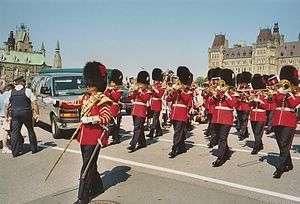
 John de Chastelain performs with the Regimental Pipes and Drums of The Calgary Highlanders
John de Chastelain performs with the Regimental Pipes and Drums of The Calgary Highlanders 402 Pipes and Drums Band from Winnipeg, Manitoba, perform at Bruce Park Cenotaph during 2008 Remembrance Day service
402 Pipes and Drums Band from Winnipeg, Manitoba, perform at Bruce Park Cenotaph during 2008 Remembrance Day service
Policy
.jpg)
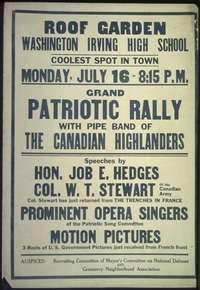
The Pipe and Drum sections and Brass and Reed section are both authorized Canadian Regular Force voluntary bands.[3] This status, as defined in Queen's Regulations and Orders Chapter 32 and the Canadian Forces Band Instructions, requires that the bands follow all of the applicable Department of National Defence and Canadian Forces regulations concerning military bands and the provision of musical support. Additionally, all band uniforms must be as described in Chapters 5 and 6 of the Canadian Forces Dress Instructions.
Festivals
Military bands and pipe bands perform at Military tattoos within and outside Canada, festivals of military bands, and at civilian competitions presenting a musical gathering of pipes and drums, musical mass performances, with choreographies and multi-media effects.
Bands in the Canadian Cadet Organizations
Volunteer bands with representatives from the regular and volunteer bands of the Armed Forces are present in all the 3 Canadian Cadet Organizations, and these are staffed mostly by proficient cadets from the aforementioned organizations.
See also
| Wikimedia Commons has media related to Military bands of Canada. |
References
- ↑ http://www.cmp-cpm.forces.gc.ca/dhh-dhp/musi/index-eng.asp
- ↑ http://www.cmp-cpm.forces.gc.ca/dhh-dhp/musi/ar/index-eng.asp
- ↑ Canadian Forces Military Bands and Marches Volume 1 Band Instructions A-PD-202-001/FP-000 (Ottawa, National Defence, 1992)
- CWO (Ret'd) Jack Kopstein CD When the Band Begins to Play: A History of Military Music in Canada (1992).
- CWO (Ret'd) Jack Kopstein CD & Ian Pearson The Heritage of Military Music in Canada (St. Catharines, Ont.: Vanwell Pub., 2002)
- CWO (Ret'd) Jack Kopstein CD & Ian Pearson The History of the Marches in Canada: Regimental/Branch/Corps (Hignell Printing Ltd, 1994).
External links
- The Naden Band of Maritime Forces Pacific in Victoria, British Columbia
- Official Website of the Royal Canadian Air Force Band
- The Royal Canadian Artillery Band Royal Canadian Artillery Band in Edmonton, Alberta
- The Central Band of the Canadian Forces in Ottawa, Ontario
- Royal 22e Régiment Band Royal 22nd Regiment Band in Quebec City, Quebec
- The Stadacona Band of Maritime Forces Atlantic in Halifax Regional Municipality
